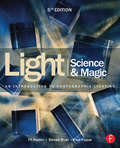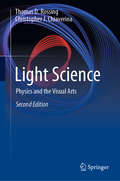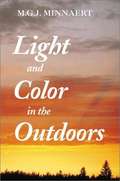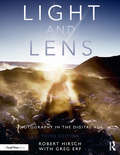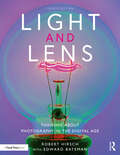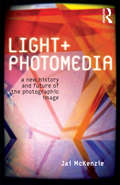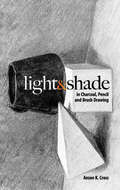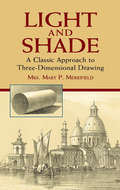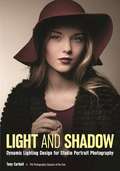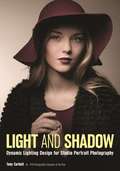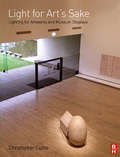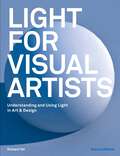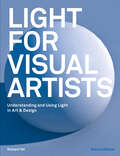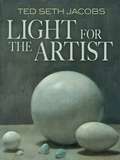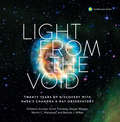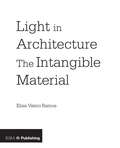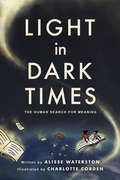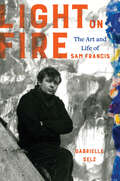- Table View
- List View
Light Pollution in Metropolises: Analysis, Impacts and Solutions
by Emlyn Etienne GoronczyLight pollution (light smog, light pollution or light emissions) is a fundamental problem in metropolises with effects on flora, fauna and people. Accordingly, the first section of the book discusses the basics of light pollution and its effects on various organisms. The characteristics of light smog in the cities of Hanover, Warsaw, Boston, New York City and Toronto are then analysed and compared. But how can the problem be tackled? Existing measures for the prevention of light pollution are discussed and further novel approaches are shown by comparing the metropolises. The book is aimed primarily at practitioners in this field and helps to identify sources of emissions and identify suitable reduction measures. This book is a translation of the original German edition „Lichtverschmutzung in Metropolen“ by Emlyn Etienne Goronczy, published by Springer Fachmedien Wiesbaden GmbH in 2018. The translation was done with the help of artificial intelligence (machine translation by the service DeepL.com). A subsequent human revision was done primarily in terms of content, so that the book will read stylistically differently from a conventional translation. Springer Nature works continuously to further the development of tools for the production of books and on the related technologies to support the authors.
Light Science & Magic: An Introduction to Photographic Lighting
by Steven Biver Fil Hunter Paul FuquaPhotographic lighting is a topic that will never go out of style, no matter how sophisticated cameras and other technology get. Even with the most high-tech gear, photographers still need to put a lot of thought and vision into lighting their photographs in order to get great results. This key skill has the power to dramatically and quickly improve photographs. Light Science and Magic provides you with a comprehensive theory of the nature and principles of light, with examples and instructions for practical application. Featuring photographs, diagrams, and step-by-step instructions, this book speaks to photographers of varying levels. It provides invaluable information on how to light the most difficult subjects, such as surfaces, metal, glass, liquids, extremes (black-on-black and white-on-white), and portraits. This new edition includes: All new chapter titled "Setting Up Your New Studio" A re-vamped and expanded chapter 8 now titled "Making Portraits" New appendix of reliable photo gear sources Over 100 new photographs and informational sidebars Updated information about advances in flash equipment, LED panels and fluorescent lights Styles of lighting continue to change, but the nature of light will always remain the same. Once photographers understand the basic physics of lighting, they can apply that knowledge to a broad range of photographic styles.
Light Science: Physics and the Visual Arts (Undergraduate Texts In Contemporary Physics Ser.)
by Thomas D. Rossing Christopher J. ChiaverinaIntended for students in the visual arts and for others with an interest in art, but with no prior knowledge of physics, this book presents the science behind what and how we see. The approach emphasises phenomena rather than mathematical theories and the joy of discovery rather than the drudgery of derivations. The text includes numerous problems, and suggestions for simple experiments, and also considers such questions as why the sky is blue, how mirrors and prisms affect the colour of light, how compact disks work, and what visual illusions can tell us about the nature of perception. It goes on to discuss such topics as the optics of the eye and camera, the different sources of light, photography and holography, colour in printing and painting, as well as computer imaging and processing.
Light and Color in the Outdoors
by L. Seymour M. G. J. MinnaertLight and Color in the Outdoors by the Dutch astronomer Marcel Minnaert (1893-1970) is a classic among books on the physics of nature. In its pages Minnaert will show you where to find the extraordinary array of light and color phenomena that may be seen in the open air; in every case he discusses their physical explanations and connections to other related phenomena. His book is intended for everybody who loves the outdoors: many of the treasures of nature presented here may even be observed in a crowded city.
Light and Layered Knits: 19 Sophisticated Designs for Every Season
by Vicki SquareCreate fluid, fashionable garments you'll wear over and over again!Best-selling author Vicki Square returns, this time creating beautiful garments made from comfortable fibers and light yarns. These are more than simply projects to make-they are truly knits to live in.The 23 patterns of Light & Layered Knits work in all climates, can be layered and removed at will, and are equally at home in a casual or workplace setting. Working with lightweight yarns in fibers such as silk, linen, cotton, and bamboo, Vicki creates pieces that will appeal to knitters of all ages.These versatile wardrobe staples-shells, fluid tops, draped tunics, light cardigans, wrap sweaters, and more-reflect the way that women dress today. What's more, most of them are conveniently sized for up to a "46" to "48" bust circumference.
Light and Lens
by Robert HirschLight & Lens: Photography in the Digital Age is a groundbreaking introductory book that clearly and concisely provides the instruction and building blocks necessary to create thought-provoking digitally based photographs. It is an adventurous idea book that features numerous classroom-tested assignments and exercises from leading photographic educators to encourage you to critically explore and make images from the photographers' eye, an aesthetic point of view. Acquire a basic foundation for digital photography. Light and Lens covers the fundamental concepts of image-making; how to use today's digital technology to create compelling images; and how to output and preserve images in the digital world.Explore the history, theory and methods of digital image-making. Light and Lens translates the enduring aesthetics of art photography into the digital realm. You'll view, capture and think about images from a new perspective.Increase your ability to analyze, discuss and write about your own work and the images of others.Learn with exercises and assignments by leading digital educators. Innovative techniques will train your eye to make the strongest visual statement.Solve visual problems and overcome image challenges. Whether you use a digital SLR or a point-and-shoot camera, you'll get new strategies to master composition, design and light. View the full range of the digital terrain with stunning images and commentary by over 190 international artists.Robert Hirsch is a renowned photographer, educator, historian and writer. His book credits include Photographic Possibilities: The Expressive Use of Ideas, Materials and Processes; Exploring Color Photography: From the Darkroom to the Digital Studio; and Seizing the Light: A History of Photography. He has had many one-person shows and curated numerous exhibitions. Hirsch has also conducted many workshops and interviewed eminent photographers of our time. The former executive director of CEPA Gallery, he is now the director of Light Research in Buffalo, New York, and on the Visual Studies faculty of University of Buffalo/The State University of New York.
Light and Lens: Photography in the Digital Age
by Robert HirschThe new edition of this pioneering book allows students to acquire an essential foundation for digital photography. Fully updated, it clearly and concisely covers the fundamental concepts of imagemaking, how to use digital technology to create compelling images, and how to output and preserve images in the digital world. Exploring history, methods, and theory, this text offers classroom-tested assignments and exercises from leading photographic educators, approaches for analyzing, discussing, and writing about photographs, and tools to critically explore and make images with increased visual literacy. New to this edition: • New larger page format • Revised and renewed to reflect technological advances • Expanded coverage of smartphone/mobile photography • Extended coverage of the careers section • More than 100 new images
Light and Lens: Thinking About Photography in the Digital Age
by Robert HirschThe latest edition of this pioneering book allows students to acquire an essential foundation for digital photography. Fully updated, it clearly and concisely covers the fundamental concepts of imagemaking, how to use digital technology to create compelling images, and how to output and preserve images in the digital world. Exploring history, methods, and theory, this text offers classroom-tested assignments and exercises from leading photographic educators, approaches for analyzing, discussing, and writing about photographs, and tools to critically explore and make images with increased visual literacy. New to this fourth edition: Completely updated and renewed to reflect social trends and technological advances Highly reconstructed Chapter 3: Image Capture: Cameras, Lenses, and Scanners Revamped Chapter 4: Exposure: Capturing the Light Entirely new Chapter 8: Digital Studio: The Virtual and the Material Worlds Expanded smartphone photography coverage Featuring nearly 300 international artists and over 360 innovative images and illustrations New engaging assignments Ideal for undergraduate students of digital photography and hobbyist photographers.
Light and Photomedia: A New History and Future of the Photographic Image (International Library Of Visual Culture Ser.)
by Jai McKenzieLight and Photomedia proposes that, regardless of technological change, the history and future of photomedia is essentially connected to light. It is a fundamental property of photomedia, binding with space and time to form and inform new, explicitly light-based structures and experiences. Jai McKenzie identifies light-space-time structures throughout the history of photomedia, from the early image machines through analogue and digital image machines to the present day. She proposes that they will continue to develop in the future and takes us to future image machines of the year 2039. With the use of the theories of Paul Virilio, Jean Baudrillard and Vilem Flusser, featuring artists including Henri Cartier-Bresson, Nam June Paik, Yves Klein, Eadweard Muybridge, Martha Rosler, Cindy Sherman and Michael Snow, as well as their photographic images, Light and Photomedia places the reader in a new history and future which, although mostly overlooked by the canon of photomedia theory, is an essential line of enquiry for contemporary thinking and dialogue in photography.
Light and Shade in Charcoal, Pencil and Brush Drawing (Dover Art Instruction)
by Anson K. CrossAn instructional book for intermediate and advanced students, this volume is also a valuable tool for teachers looking to master the principles of light and shade. One of the most in-depth treatments available, it offers a wealth of details on mediums and techniques, including natural and artificial light, gradations, and more.Author Anson K. Cross begins with studies of chiaro-oscura, or light and shade, and examples of values and their tests. He discusses the aims of students and artists and offers some general advice on technique and method before exploring the specifics of charcoal, pencil, and brush drawing. Sixty-five black-and-white illustrations, many of them drawn by students, appear throughout the book.
Light and Shade: A Classic Approach to Three-Dimensional Drawing
by Mary Merrifield"Form," writes the author, "is developed by means of light and shade; without these every object would appear flat." Originally published in the mid-nineteenth century, this classic approach to three-dimensional drawing was the first book to provide art students with instructions for correctly illustrating perspective outlines of various objects. An art historian noted for her authoritative reference works, Merrifield clearly demonstrates the principles of light and shade by revealing the effects of common daylight, sunshine, and candle or artificial light on geometrical solids. Her simple explanations are accompanied by illustrations of cubes, prisms, pyramids, cylinders, spheres, ovals, and cones.As useful and practical today as it was when first published well over a century ago, Light and Shade provides beginning and advanced art students with valuable insights into effective drawing and sketching.
Light and Shadow
by Tony CorbellStudio lighting offers portrait photographers unlimited creative control. Mastering its use requires a specific skill set, however. Fortunately, portrait photography legend Tony Corbell is up to the task of showing readers how to harness its full power. He sets a foundation for mastering the use of strobes and continuous lighting sources (LEDs, tungsten lights, and fluorescent sources), creating effective lighting setups (with the aid of detailed, yet simple-to-understand diagrams), metering and adjusting the light, correcting color imbalances, softening harsh shadows, and more. He also introduces readers to the proper use of standard photographic modifiers -- softboxes, umbrellas, octoboxes, beauty dishes, and other tools -- so that they can sculpt their every portrait subject with incredibly flattering light. This book is filled with over 150 inspiring and instructive images from a true master of the craft. In these pages, readers will learn step-by-step instructions for mastering the many critical concepts one must understand to gain mastery over light. Armed with simple strategies for studio lighting, readers can repeatedly re-create Corbell’s award-winning portrait lighting looks with their own clients.
Light and Shadow
by Tony CorbellStudio lighting offers portrait photographers unlimited creative control. Mastering its use requires a specific skill set, however. Fortunately, portrait photography legend Tony Corbell is up to the task of showing readers how to harness its full power. He sets a foundation for mastering the use of strobes and continuous lighting sources (LEDs, tungsten lights, and fluorescent sources), creating effective lighting setups (with the aid of detailed, yet simple-to-understand diagrams), metering and adjusting the light, correcting color imbalances, softening harsh shadows, and more. He also introduces readers to the proper use of standard photographic modifiers -- softboxes, umbrellas, octoboxes, beauty dishes, and other tools -- so that they can sculpt their every portrait subject with incredibly flattering light. This book is filled with over 150 inspiring and instructive images from a true master of the craft. In these pages, readers will learn step-by-step instructions for mastering the many critical concepts one must understand to gain mastery over light. Armed with simple strategies for studio lighting, readers can repeatedly re-create Corbell’s award-winning portrait lighting looks with their own clients.
Light for Art's Sake
by Christopher CuttleConservation scientists in museums and galleries have a clear understanding of the damage that light can inflict on an object, but what of the designers that create exhibitions to display these precious items? Light for Arts Sake provides a basis for a level of professional expertise for lighting practice in museums. Rather than portraying conservation and display as having diametrically opposed objectives, the central concept is that the interaction of light and art media is the source for both the visual experience and the degradation of the artwork. Optimal solutions derive from understanding and controlling the interaction process, and the need is for the level of understanding among lighting professionals to be brought closer to that found among conservation scientists.
Light for Visual Artists Second Edition: Understanding, Using Light in Art & Design
by Richard YotThis introduction to light for students and visual artists explores the way light can be used to create realistic and fantastical effects in a wide range of media. Divided into three parts, the clearly written text explains: the fundamental properties of natural and artificial light; how to create realistic images by observing people and the environment; the creative use of light in composition and design. Updated with revised photos and artwork, as well as 15 practical exercises and new online video material, this second edition is an indispensable resource for animators, digital illustrators, painters, photographers and artists working in any medium.
Light for Visual Artists Second Edition: Understanding, Using Light in Art & Design
by Richard YotThis introduction to light for students and visual artists explores the way light can be used to create realistic and fantastical effects in a wide range of media. Divided into three parts, the clearly written text explains: the fundamental properties of natural and artificial light; how to create realistic images by observing people and the environment; the creative use of light in composition and design. Updated with revised photos and artwork, as well as 15 practical exercises and new online video material, this second edition is an indispensable resource for animators, digital illustrators, painters, photographers and artists working in any medium.
Light for Visual Artists: Understanding & Using Light in Art & Design
by Richard YotLight is as important as colour in creating the right effect, whether on a palette or on a computer. Whether you’re an animator, painter, photographer or illustrator, you need to know how to harness light in your work to create the right effect. Light for Visual Artists is the first and only book that explores the way light can be used to create realistic and fantastical effects in a wide range of media. Illustrator Richard Yot, known for his work in film as a lighting artist and stylised 3D illustrations, takes you through the fundamental properties of natural and artificial light, shadows, the interaction of light on different types of surfaces, reflections, as well as transparency, translucency and the effects of light on colour. Richard also explores how to observe the effects of light to create realistic images, and the creative use of light in composition and design for creating moods or setting a scene. This second edition has been updated with revised photos and artwork, as well as 15 practical exercises and new online video material.Packed with diagrams and illustrations, as well as computer game and film stills, Light for Visual Artists is an invaluable resource for animators, digital illustrators, painters, photographers and artists working in any medium.
Light for Visual Artists: Understanding And Using Light In Art And Design
by Richard YotLight is as important as colour in creating the right effect, whether on a palette or on a computer. Whether you’re an animator, painter, photographer or illustrator, you need to know how to harness light in your work to create the right effect. Light for Visual Artists is the first and only book that explores the way light can be used to create realistic and fantastical effects in a wide range of media. Illustrator Richard Yot, known for his work in film as a lighting artist and stylised 3D illustrations, takes you through the fundamental properties of natural and artificial light, shadows, the interaction of light on different types of surfaces, reflections, as well as transparency, translucency and the effects of light on colour. Richard also explores how to observe the effects of light to create realistic images, and the creative use of light in composition and design for creating moods or setting a scene. This second edition has been updated with revised photos and artwork, as well as 15 practical exercises and new online video material.Packed with diagrams and illustrations, as well as computer game and film stills, Light for Visual Artists is an invaluable resource for animators, digital illustrators, painters, photographers and artists working in any medium.
Light for a Cold Land: Lawren Harris's Life and Work
by Peter LariseyLawren Stewart Harris’ artistic career began in the first decade of our century. Well known for the nationalist-inspired landscapes that he painted between 1908 and 1932, Harris turned resolutely in 1934 to the painting of abstractions. He continued to create works that reflected his own modernist and mystical developments until the end of his life. Canadians praise Harris’ landscapes and admire him as a planner of innovative and heroic-sounding sketching trips into the North. He is also recognized as the chief organizer of the Group of Seven. A long list of younger artists he considered creative greatly benefited from Harris’ encouragement and often generous, practical help; many of them have been interviewed for this book. In the lives of some Canadians harris still functions as a gurulike guide – a role he was quite content to take on during his own lifetime – because of the spiritual content of his art and aesthetic writings and the example of his optimistic, vigorous and apparently untroubled life. But Harris’ was not an untroubled life, and Light for a Cold Land examines his personal crises and difficulties, some of which caused important changes in his art. The book also uncovers the painting styles, artistic tensions and cultural dynamics of the German milieu in which Harris received his only formal art education. His student years in Berlin profoundly influenced not only his art but also his artistic politics and his philosophy. It is ironic that in the art of this most articulate of Canadian nationalist painters, there are extensive German influences. Light for a Cold Land is the first art-historical study of Lawren Harris that attempts to explore his life and all aspects of his career. It is based on extensive work in archives, libraries, public art galleries and private collections in Canada, as well as research in Germany and interviews with members of Harris’ family and many of his friends, acquaintances, colleagues and critics.
Light for the Artist (Dover Art Instruction)
by Ted Seth JacobsIntermediate and advanced art students receive a broad vocabulary of effects with this in-depth study of light. Topics include basics, use of light to define form and space, field effects, colored light, and many other subjects. Diagrams and paintings illustrate applications of principles to figure, still life, and landscape paintings.
Light from the Void: Twenty Years of Discovery with NASA's Chandra X-ray Observatory
by Kimberly K. Arcand Megan Watzke Grant Tremblay Martin C. Weisskoph Belinda J. WilkesA lavish coffee-table book featuring spectacular images from the Chandra X-Ray Observatory, the most powerful X-Ray telescope ever builtTake a journey through the cosmos with Light from the Void, a stunning collection of photographs from the Chandra X-Ray Observatory's two decades of operation. The book showcases rarely-seen celestial phenomena such as black holes, planetary nebulae, galaxy clusters, gravitational waves, stellar birth and death, and more. Accompanying these images of incredible natural phenomena are captions explaining how they occur. The images start close to home and move outward: beginning with images of the Chandra launch, then moving into the solar system, through the nearby universe, and finally to the most distant galaxies Chandra has observed, the book brings readers on a far-out visual voyage.
Light in Architecture: The Intangible Material
by Elisa Valero RamosLight in Architecture explores the role and use of light in and around buildings from the time that Stonehenge was built through to the present day, illustrating how a greater understanding of this intangible and free material will lead us to better architecture and, ultimately, improve our quality of life. Translated and carefully updated from the best-selling Spanish book, La Materia Intangible, this full colour edition explains why light is so fundamental to human perception, how its nature and use are influenced by time and place, and how it has come to be used as a tool for abstract architectural design. Drawing on centuries of thinking and over 40 real-life, international exemplars, the book explores the different ways that light can be harnessed and manipulated to achieve particular objectives, emotions or experiences, as well as how the technologies and techniques for doing so have developed over time.
Light in Dark Times: The Human Search for Meaning (ethnoGRAPHIC)
by Alisse WaterstonWhat will become of us in these trying times? How will we pass the time that we have on earth? In gorgeously rendered graphic form, Light in Dark Times invites readers to consider these questions by exploring the political catastrophes and moral disasters of the past and present, revealing issues that beg to be studied, understood, confronted, and resisted. A profound work of anthropology and art, this book is for anyone yearning to understand the darkness and hoping to hold onto the light. It is a powerful story of encounters with writers, philosophers, activists, and anthropologists whose words are as meaningful today as they were during the times in which they were written. This book is at once a lament over the darkness of our times, an affirmation of the value of knowledge and introspection, and a consideration of truth, lies, and the dangers of the trivial. In a time when many of us struggle with the feeling that we cannot do enough to change the course of the future, this book is a call to action, asking us to envision and create an alternative world from the one in which we now live. Light in Dark Times is beautiful to look at and to hold – an exquisite work of art that is lively, informative, enlightening, deeply moving, and inspiring.
Light of India: A Conflagration of Indian Matchbox Art
by Warren DotzWith all the zany vibrancy of a Bollywood musical, the colorful matchbox labels of LIGHT OF INDIA present a fascinating confluence of popular culture and a sophisticated graphic arts tradition that stretches back for centuries. Populated with pouncing Bengal tigers, regal jungle elephants, and Hindu gods and goddesses, these miniature masterpieces are worlds unto themselves, skillfully illustrated with a naive yet irresistible charm. This delightful art book is sure to fire the imagination of all who wish to study, preserve, and celebrate India's more humble, but no less brilliant, visual arts heritage. A dazzling collection of more than 300 vintage matchbox labels from India, dating from the turn of the century through the 1950s. Includes a discussion of Hindu iconography, recurring visual themes and symbols, and the cultural and historical significance of matchbox art. A great resource for graphic artists and designers, collectors of paper ephemera or advertising art, and students of Indian culture. Gift edition slipcase includes a textured novelty "striker strip" along the spine.
Light on Fire: The Art and Life of Sam Francis
by Gabrielle SelzThe first in-depth biography of Sam Francis, the legendary American abstract painter who broke all the rules in his personal and artistic life.Light on Fire is the first comprehensive biography of Sam Francis, one of the most important American abstract artists of the twentieth century. Based on Gabrielle Selz’s unprecedented access to Francis’s files, as well as private correspondence and hundreds of interviews, this book traces the extraordinary and ultimately tragic journey of a complex and charismatic artist who first learned to paint as a former air-corps pilot encased for three years in a full-body cast. While still a young man, Francis saw his color-saturated paintings fetch the highest prices of any living artist. His restless desire resulted in five marriages and homes on three continents; his entrepreneurial spirit led to founding a museum, a publishing company, a reforestation program and several nonprofits. Light on Fire captures the art, life, personality, and talent of a man whom the art historian and museum director William C. Agee described as a rare artist participating in the "visionary reconstruction of art history," defying creative boundaries among the likes of Jackson Pollock, Mark Rothko, and Willem de Kooning. With settings from World War II San Francisco to postwar Paris, New York, Tokyo, and Los Angeles, Selz crafts an intimate portrait of a man who sought to resolve in art the contradictions he couldn’t resolve in life.

